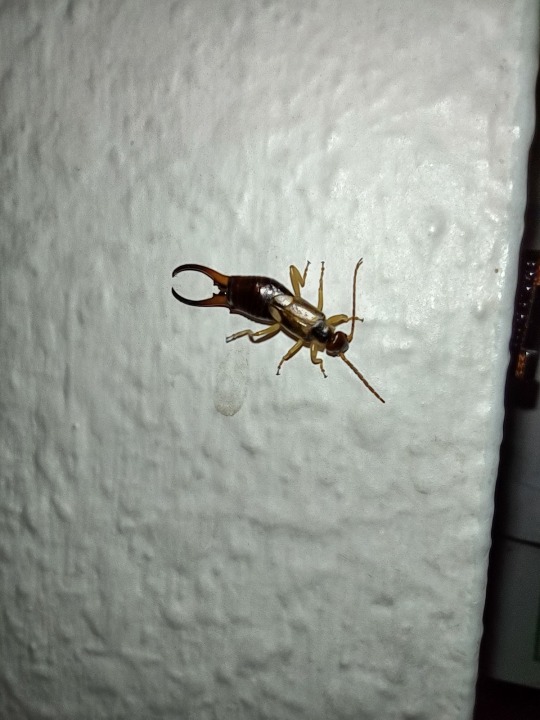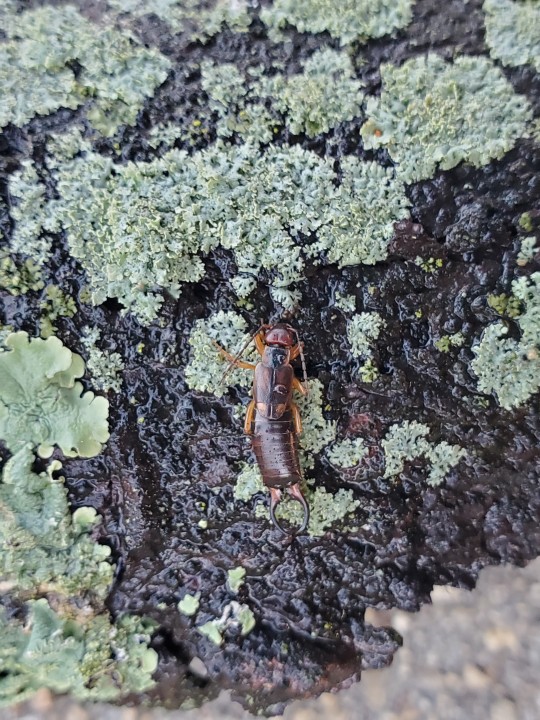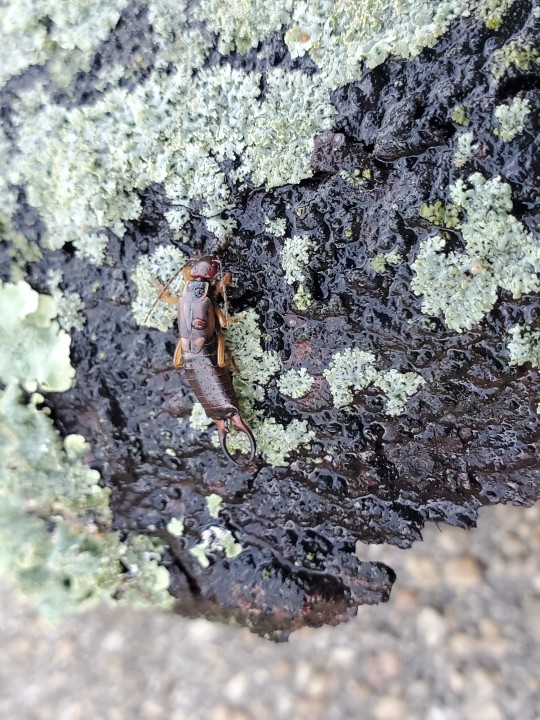#european earwig
Text

Grzimek's Animal Life Encyclopedia: vol. 2 - Insects. Written by Dr. Bernhard Grzimek. 1984.
Internet Archive
1.) Wart-biter (Decticus verrucivorus)
2.) Great green bush-cricket (Tettigonia viridissima)
3.) Saddle-backed bush cricket (Ephippiger ephippiger)
4.) European earwig (Forficula auricularia)
#bugs#insects#bush crickets#wart-biter#great green bush-cricket#saddle-backed bush cricket#earwigs#european earwig#signature
346 notes
·
View notes
Text

Lovely lady (based on the straight cerci) chilling on the curtains.
Female European Earwig (Forficula auricularia agg.), Ireland
#bugs#insects#bugblr#european earwig#forficula auricularia#forficula#forficulidae#dermaptera#earwigs#animals#photography#wildlife photography
31 notes
·
View notes
Text

@qyuryyus submitted: this fella with huge pincers spotted by my sister! i've never seen a pincher butt as big as this one. ID not necessary but would be cool to know! central valley, CA
What a man! Incredible butt snippers. Looks like a male European earwig, though that species is being split into two separate species and I don't know the differences yet!
83 notes
·
View notes
Text










Found a European Earwig at work, they're actually really pretty! I haven't really taken the time to examine one up close before.
16 notes
·
View notes
Text


Found some earwigs at work today (highlight of my shift), the one on the right was a bit more energized than the other lol
Also here’s this video of one of them cleaning its antennae. Please ignore my ugly snort laugh, I thought it was funny,,.
#earwig gets the zoomies (real not clickbait)#earwig#earwigs#dermaptera#european earwig#forficula auricularia#also i just learned that ‘forficula auricularia’ is not used to describe a single species#but a species complex!#the species within the complex are so similar that they can’t be morphologically distinguished!#interesting stuff#bug cw#insect cw#not art
4 notes
·
View notes
Text


🤍🤍🤍
#They're like angels to me. You understand#bugs#buffalo treehopper#<molt from a nymph. wonder where the adult is...#european earwig#treehoppers#earwigs#my photos#.woof.
3 notes
·
View notes
Text


European Earwig (male, curved ), Forficula auricularia
4 notes
·
View notes
Text

◇ Forficula Auricularia ◇
Among the circles I have been within, I've found Earwigs to be a relatively under-appreciated insect. Though frequently in the position of a pest, Forficulidae are relatively harmless and occasionally beneficial. Beyond being the hunters of different crop pests, Earwigs harbor a fascinating ability. They've a unique set of wings that unfurl to a size that is ten-fold their starting scale; in a manner often compared to origami. An unassuming and overlooked insect with a shimmering set of intricate wings. This particular fella is a Common or European Earwig.
Not wholly confident in this attempt to draw an iridescent effect in my style, but I think it is serviceable.
-=◇=-
0 notes
Photo










European Earwig - Forficula auricularia
It appears I’m following a theme this week of common detritivore insects that are much appreciated in the wild, but aren’t so much appreciated by people. Honestly, these insects may be considered more worrisome and repulsive than Roaches, but any fear or disdain shouldn’t be warranted. While they may slither around as they move, tuck themselves into cracks and crevices, and while those pincers on their abdomen may look fearsome, Earwigs aren’t aggressive. They may look strange, but they’re insects so they’re bound to have many features that make them distinct enough to classified as an order. If you can stomach looking at them, there’s quite a bit to learn about them. One thing I’ve learned recently about Dermapterans is that the shape of a male’s pincers can be a precise and massive help for identifying which Earwig is in your plants. They won’t exactly be hidden as Earwigs raise their forceps to intimidate if they need to fight or defend. I’ve mentioned before that the pincers differ between males and females (curved vs. straight in this specie), but apparently across the order (at least in North America), female Earwigs tend to have straightened pincers. Male pincers are more unique and feature a variety of sizes, shapes, serrations, and curvatures.
As an example, the specimens here are just one specie inside the family of common Earwigs knowns as Forficulidae. If you were to examine another branch of the Earwig family tree such as Chelisochidae (the Black Earwigs), the differences in pincers become more than apparent. Obviously there are more differences besides that, but since the pincers are the most prominent feature - and what people seem to fear about them - they’re great to focus on. Moreover, there have been mating pairs of insects featured on this blog before in many formations, but what of Earwigs? Whether on top or back to back, wouldn’t those pincers get in the way? Not at all! The ones I’ve seen go back to back and are able to orient themselves so the pincers either stay out of the way or can be used during the process, depending on the specie. As a result, Earwig nymphs are abundant during the warmer months and they greatly resemble the adults. As with Hemipterans, the easiest way to tell (aside from size) is to look at the wings. If the wings aren’t full, the insect is still young. There’s a few nymphs hiding in the plants photographed here actually. To try and find them! Another hint I’ll give is that juvenile Forficula Earwigs start with shortened antennae, but gradually gain another segment which each molt until reaching 12 segments in adulthood!
Pictures were taken on June 10 and 23, July 6 and 12, and September 5, 2021 with a Google Pixel 4.
#jonny’s insect catalogue#ontario insect#earwig#european earwig#dermaptera#insect#toronto#june2021#july2021#september2021#2021#entomology#nature#invertebrates#arthropods
0 notes
Text



im back from outside check out bugs
#first one is an earwig probably european earwig#second one i think is a banded fishing spider#idk wtf that third one is some kind of cricket#i am a pro at iding bugs#bugs
2 notes
·
View notes
Text
I scrolled too fast and thought the university had a subscription to European Demonology instead of European Dermatology.
0 notes
Text

European Starling (Sturnus vulgaris)
Habitat & Distribution
Native to Eurasia, especially Europe, North Africa, and western and central Asia
In the wild they reside in open grasslands and sparse woodlands, but they have also adapted well to living in urban environments
Physical Description
Weight: 58–101 g (2.0–3.6 oz)
Wingspan: 19–23 cm (7.5–9.1 in)
Both males and females have iridescent black plumage with white or yellow speckled markings across the whole body
Behaviour
Individuals live in large flocks, sometimes with over a million members
European starlings are mainly insectivorous, feeding on a variety of species including spiders, flies, moths, grasshoppers, and earwigs
The main predators of European starlings are owls birds of prey; starlings avoid predation by flying in large groups
Key Advantages
European starlings are very agile, and their flight patterns in large groups can confuse predators
Their sharp beaks are a powerful deterrent against potential threats when nesting
See where they stand in the May Mammal Madness Tournament here!
Photo by Kenneth Haas
91 notes
·
View notes
Photo

@grumpyoldsnake submitted: Found while picking apples in [removed] [please remove location] this fall! Not sure what it is, but its bite or pinch or spit or what have you stung quite a bit and left behind a yellowish fluid. Would have never managed a look at what got me if it hadn’t fallen into my basket and let me dump it out somewhere easier to see, hah.
It’s a male European earwig! Obviously given the name they are not native to your area but they’ve been here a long time and are here to stay. They can bite with their mouth or pinch with their butt forceps and the yellow stuff is a defensive fluid they can secrete when feeling threatened. But they are still cute and I love them :)
128 notes
·
View notes
Text
earwig (order Dermaptera) info-dump bc they're really cool insects that have really unique behaviors
- there are about 2,000 different species of earwigs, 10 of which are native to north america. earwigs when in there native ranges are extremely beneficial to the environment
- the european earwig (Forficula auricularia) is an invasive species in north america, and unfortunately is now a super common insect to see
- earwigs are edible! i have been told they taste like soft shell crab
- earwigs are extremely maternal, once a female earwig legs eggs she will care for them until adulthood. this is rare, only about 1% of all insects are maternal
- hump earwigs (Anechura harmandi) commit what's called matriphagy. after months of the mom raising her young, the offspring will then consume her
- sometimes earwig moms will abuse/neglect their young. those young will then share food and take care of each other, typically those behaviors are only seen in social Hymenoptera (bees, ants, and wasps)
- earwigs have some of the most intricate wings. there's about 20 different fold lines, and fold up to be 10x or more smaller than when the earwig is in flight. no other animal wing is this complex
- the giant earwig (Labidura herculeana) now extinct grew to be about 3 inches long
bonus photo of my earwig tattoo :)

#earwigs are so neat#order Dermaptera#dermaptera#earwigs#insects#bugs#entomology#special interest#infodump#tattoo#bug talks#bug tattoo#bug facts#insect facts
77 notes
·
View notes
Note

Can you identify this lil guy I came across last night? Area is Northern Virigina, United States.
the most prominent and easily encountered earwig in the area, invasive European earwig, Forficula auricularia
56 notes
·
View notes
Text






recent buggies i have held :3 I BELIEVE they are:
-european earwig
-green striped grasshopper
-green lacewing
-carolina grasshopper/locust
-terrestrial isopod (I do not know isopod species sorry)
-bumblebee (I do not know specific bumblebee species either sorry)
these were all taken in southeast nebraska if anyone wants to correct me on an ID or help me ID the bee!
#bugs#insects#earwig#grasshopper#lacewing#isopod#bumblebee#i'm most hesitant about the green striped grasshopper tbh i feel like i could be wrong on that one#the others i'm pretty confident about#i <3 buggiesssssss
8 notes
·
View notes